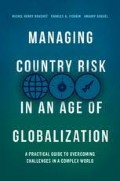Abstract
This chapter continues to explore the dependency links and contamination channels of the globalized new economy. Here, the focus is on integrated areas with pegged exchange rates or an irreversibly fixed exchange rate (single currency area) such as the Eurozone. This chapter also analyses the integration of the balance of payments and the key role of central banks in integrated areas. This chapter further examines why pegged exchange rates introduce new sources of vulnerability. To answer that question, we also explore a concept known as a “twin crisis” in which there is both a currency crisis and a banking crisis. We also explore two case studies: the Brexit and its consequences and China’s impact on the global financial system.
Access this chapter
Tax calculation will be finalised at checkout
Purchases are for personal use only
References
Acemoglu, Daron, and James A. Robinson. 2012. Why Nations Fail: The Origins of Power, Prosperity, and Poverty. New York: Crown Publishers.
Aizenman, Joshua, and Hiro Ito. 2012. “Trilemma Policy Convergence Patterns and Output Volatility.” NBER Working Paper No. 17806.
Aldo, Musacchio, and Sergio G. Lazzarini. 2012. “Leviathan in Business: Varieties of State Capitalism and Their Implications for Economic Performance.” Harvard Business School Working Paper No. 12-108, June.
Beck, Hanno, and Aloys Prinz. 2012. The Trilemma of a Monetary Union: Another Impossible Trinity. Intereconomics 47 (1): 39–43.
Calvo, Guillermo A., Alejandro Izquierdo, and Luis-Fernando Mejia. 2004. “On the Empirics of Sudden Stops: The Relevance of Balance-Sheet Effects.” NBER Working Paper No. 10520.
Cozzi, Giovanni, and Terry Mckinley. 2016. “The United Kingdom’s Brexit Vote Leads to a Major Economic Shock.” Policy Brief 12-2016. Greenwich Political Economy Research Center.
De Souza, Eric. 2012. “European Macroeconomic Policy.” Special Topics. College of Europe Lectures.
Dhingra, Swati, Gianmarco Ottaviano, Thomas Sampson, and John Van Reenen. 2016. “The Impact of Brexit on Foreign Investment in the UK.” CEP Brexit Analysis No. 3. Centre for Economic Performance.
Dornbusch, Rudiger. 2012. United States Congress. Senate. Committee on the Budget. Concurrent Resolution on the Budget Fiscal Year 2013.
ECB Bulletin. 2011. TARGET2 Balances of National Central Banks in the Euro Area. Economic and Monetary Developments, October.
Eichengreen, Barry, and Charles Wyplosz. 1998. “Stability Pact: More Than a Minor Nuisance.” Economic Policy 13 (26): 65–113.
Elliott, Douglas, Arthur Kroeber, and Yu Qiao. 2015. “Shadow Banking in China: A Primer.” Economic Studies. The Brookings Institution.
European Commission. 1990. “One Market, One Money Report. An Evaluation of the Potential Benefits and Costs of Forming an Economic and Monetary Union.” European Economy, No. 44, October.
European Parliament. 2017. Global Systemically Important Banks in Europe, Listed in November 16, 2016. Briefing, Economic Governance Support Unit.
Forest, Kieran. 2016. “Economic Implication of Brexit.” MSc Thesis, Skema Business School.
Garber, Peter M. 1998. “Notes on the Role of TARGET in a Stage III Crisis.” NBER Working Paper No. 6619.
Huang, Zheping. 2017. “260% of GDP: A Quick Look at the Debt Levels That Earned China a Rating Downgrade.” Quartz, May 22.
IMF. 2016. “Annual Report on Exchange Arrangements and Exchange Restrictions (AREAER).” November 11.
Ingram, James, C. 1973. “The Case for European Monetary Integration.” International Finance Section, Department of Economics, Princeton University, Essays in International Finance No. 98, April.
Jenkins, Patrick, 2017. “UK Businesses Want Answers on Brexit Deal.” Financial Times, September 24.
Kaminsky, Graciela L., and Carmen M. Reinhart. 1999. “The Twin Crises: The Causes of Banking and Balance-of-Payments Problems.” The American Economic Review 89 (3): 473–500.
Kenen, Peter. 1969. “The Theory of Optimum Currency Areas: An Eclectic View.” In Monetary Problems of the International Economy, edited by Robert A. Mundell and Alexander K. Swoboda. Chicago: The University of Chicago Press.
Keohane, David. 2017. “Big Is Beautiful, China Banks.” Financial Times, March 28.
Merler, Silvia, and Jean Pisani-Ferry. 2012a. “Sudden Stops in the Euro Area.” Review of Economics and Institutions 3 (3): 1–23.
Merler, Silvia, and Jean Pisani-Ferry. 2012b. “Capital Flight in the Euro Area: From Bad to Worse.” Blog Post, Bruegel, July 13.
Minford, Patrick. 2010. Benefits and Costs of Forming an Economic and Monetary Union to the UK Economy. Cardiff University, Cardiff Business School, Economics Section.
Pisani-Ferry, Jean. 2012. “The Euro Crisis and the New Impossible Trinity.” Bruegel Policy Contribution.
Schiavenza, Matt. 2013. Want to Understand How China Is Doing? Don’t Look at GDP. Why the Classic Benchmark Statistic Is Unsuitable to Describing the World’s Second-Largest Economy. https://www.Theatlantic.com, October 4.
Strauss, Delphine. 2016. “CBI Chief Says Brexit Would Leave Economy Weaker 15 Years On.” Financial Times, March 20.
Wang, Yikay. 2014. “Will China Escape the Middle-Income Trap? A Politico-Economic Theory of Growth and State Capitalism.” Working Paper, University of Zurich.
Wolf, Martin. 2011. “Intolerable Choices for the Eurozone. At Stake Is Closer Union or Partial Dissolution.” Financial Times, May 31.
Wolf, Martin. 2017. “China Faces a Tough Fight to Escape Its Debt Trap.” Financial Times, April 11.
World Bank. 2017. “International Debt Statistics.” External Debt.
Author information
Authors and Affiliations
Corresponding author
Rights and permissions
Copyright information
© 2018 The Author(s)
About this chapter
Cite this chapter
Bouchet, M.H., Fishkin, C.A., Goguel, A. (2018). Fragility and Vulnerability of Integrated Areas. In: Managing Country Risk in an Age of Globalization. Palgrave Macmillan, Cham. https://doi.org/10.1007/978-3-319-89752-3_7
Download citation
DOI: https://doi.org/10.1007/978-3-319-89752-3_7
Published:
Publisher Name: Palgrave Macmillan, Cham
Print ISBN: 978-3-319-89751-6
Online ISBN: 978-3-319-89752-3
eBook Packages: Economics and FinanceEconomics and Finance (R0)

